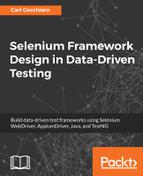Book Description
Take a deep dive into building data-driven test frameworks using Selenium WebDriver
About This Book
- A comprehensive guide to designing data-driven test frameworks using the Selenium 3 WebDriver API, AppiumDriver API, Java-Bindings, and TestNG
- Learn how to use Selenium Page Object Design Patterns and D.R.Y. (Don't Repeat Yourself) Approaches to software development in automated testing
- Discover the Selenium Grid Architecture and build your own grid for browser and mobile devices
- Use third party tools and services like ExtentReports for results processing, reporting, and SauceLabs for cloud-based test services
Who This Book Is For
This book is intended for software quality assurance/testing professionals, software project managers, or software developers with prior experience in using Selenium and Java to test web-based applications.This book is geared towards the quality assurance and development professionals responsible for designing and building enterprise-based testing frameworks.The user should have a working knowledge of the Java, TestNG, and Selenium technologies
What You Will Learn
- Design the Selenium Driver Class for local, remote, and third party grid support
- Build Page Object Classes using the Selenium Page Object Model
- Develop Data-Driven Test Classes using the TestNG framework
- Encapsulate Data using the JSON Protocol
- Build a Selenium Grid for RemoteWebDriver Testing
- Construct Utility Classes for use in Synchronization, File I/O, Reporting and Test Listener Classes
- Run the sample framework and see the benefits of a live data-driven framework in real-time
In Detail
The Selenium WebDriver 3.x Technology is an open source API available to test both Browser and Mobile applications. It is completely platform independent in that tests built for one browser or mobile device, will also work on all other browsers and mobile devices. Selenium supports all major development languages which allow it to be tied directly into the technology used to develop the applications. This guide will provide a step-by-step approach to designing and building a data-driven test framework using Selenium WebDriver, Java, and TestNG.
The book starts off by introducing users to the Selenium Page Object Design Patterns and D.R.Y Approaches to Software Development. In doing so, it covers designing and building a Selenium WebDriver framework that supports both Browser and Mobile Devices. It will lead the user through a journey of architecting their own framework with a scalable driver class, Java utility classes, JSON Data Provider, Data-Driven Test Classes, and support for third party tools and plugins.
Users will learn how to design and build a Selenium Grid from scratch to allow the framework to scale and support different browsers, mobile devices, versions, and platforms, and how they can leverage third party grids in the Cloud like SauceLabs.
Other topics covered include designing abstract base and sub-classes, inheritance, dual-driver support, parallel testing, testing multi-branded applications, best practices for using locators, and data encapsulation.
Finally, you will be presented with a sample fully-functional framework to get them up and running with the Selenium WebDriver for browser testing.
By the end of the book, you will be able to design your own automation testing framework and perform data-driven testing with Selenium WebDriver.
Style and approach
A comprehensive approach to designing data-driven test frameworks using the Selenium 3 WebDriver API, Java-Bindings, and TestNG Technologies
Downloading the example code for this book You can download the example code files for all Packt books you have purchased from your account at http://www.PacktPub.com. If you purchased this book elsewhere, you can visit http://www.PacktPub.com/support and register to have the files e-mailed directly to you.
Table of Contents
- Preface
- Building a Scalable Selenium Test Driver Class for Web and Mobile Applications
- Introduction
- The singleton driver class
- Using preferences to support browsers and platforms
- Using preferences to support mobile device simulators, emulators, and real devices
- Multithreading support for parallel and distributed testing
- Passing optional arguments and parameters to the driver
- Selenium Grid Architecture support using the RemoteWebDriver and AppiumDriver classes
- Third-party grid architecture support including the Sauce Labs Test Cloud
- Using property files to select browsers, devices, versions, platforms, languages, and many more
- Summary
- Selenium Framework Utility Classes
- Best Practices for Building Selenium Page Object Classes
- Introduction
- Best practices for naming conventions, comments, and folder structures
- Designing and building the abstract base classes for the AUT
- Designing and building subclasses for feature-specific pages using inheritance techniques
- Encapsulation and using getter/setter methods to retrieve objects from the page object classes
- Exception handling and synchronization in page object class methods
- Table classes
- Summary
- Defining WebDriver and AppiumDriver Page Object Elements
- Building a JSON Data Provider
- Developing Data-Driven Test Classes
- Introduction
- Annotating test class methods using TestNG
- TestNG setup/teardown methods
- Naming conventions for test methods
- Using the TestNG DataProvider
- Calling page object methods in test classes
- Exception handling in test classes
- Designing base setup classes
- TestNG suite file structure
- Suite parameters
- Summary
- Encapsulating Data in Data-Driven Testing
- Introduction
- Casting JSON data to Java objects
- Building in positive, negative, boundary, and limit testing
- Confirmation and exception property files
- Property files and parsing test data on the fly
- Global variables versus dynamic data
- Processing JVM args
- Retrieving JSON data outside of test methods
- Supporting multibranded applications
- Multiple driver support
- Parallel testing
- Summary
- Designing a Selenium Grid
- Introduction
- Virtual grids
- Selenium driver class – WebDriver versus RemoteWebDriver
- Switching from local to remote driver
- Selenium standalone server and client drivers
- Selenium standalone server and browser driver command-line options
- Appium server and mobile simulator/emulator command-line options
- Selenium Grid console
- Directing traffic to Selenium nodes
- Third-Party Tools and Plugins
- Working Selenium WebDriver Framework Samples
